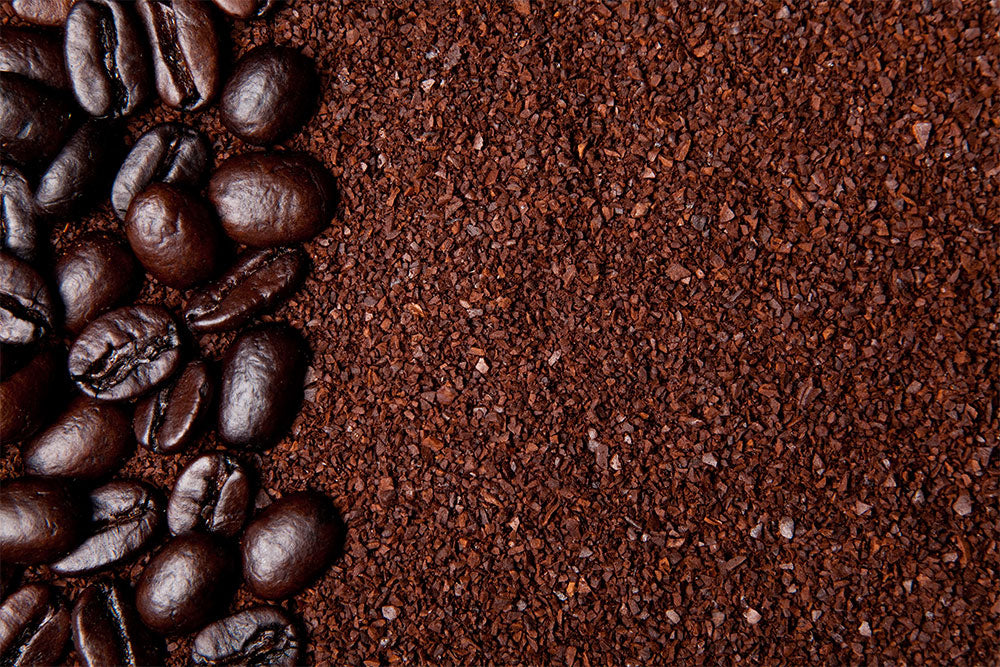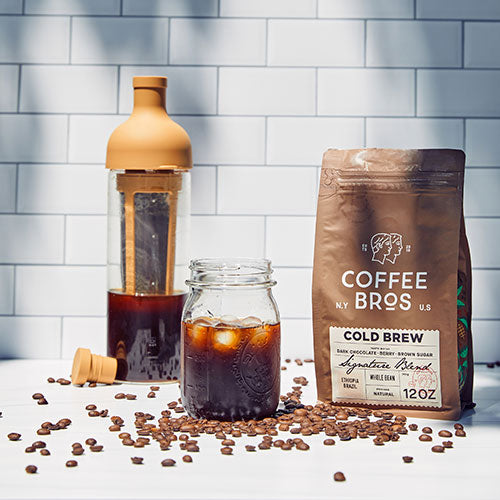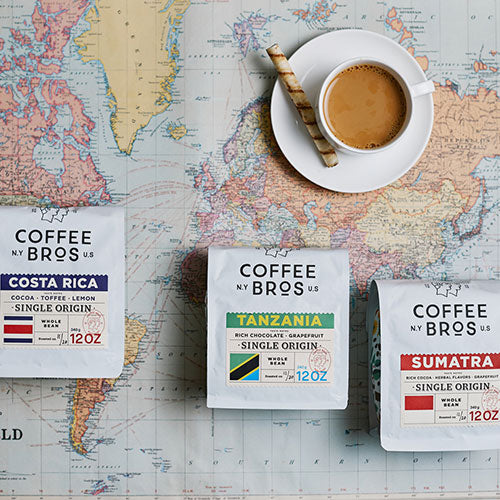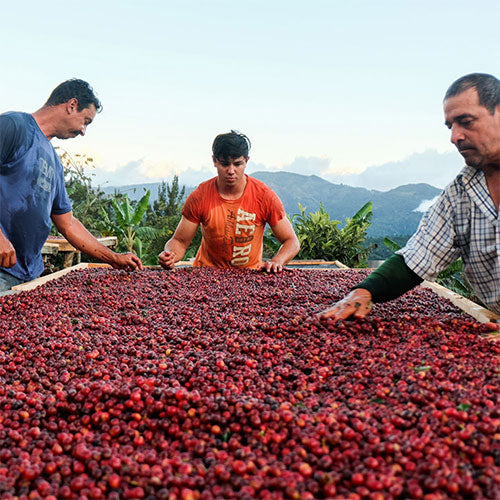Whole Bean Coffee vs. Ground Coffee: All Differences Explained
Introduction
Today, we aim to highlight the significant differences between purchasing pre-ground coffee and whole-bean coffee. By the end of this article, you will gain insight into why buying whole-bean coffee consistently surpasses its pre-ground alternative in terms of freshness, flavor, versatility, longevity, and consistency. If you are passionate about coffee and want to improve your coffee experience, keep reading, and we hope to convince you to reconsider purchasing pre-ground coffee.
Whole Bean Coffee vs. Ground Coffee: Table of Contents
- What is Whole Bean Coffee
- What is Ground Coffee
-
Top 5 Reasons Why You Should Buy Whole Bean Coffee
- Freshness: Whole bean coffee stays fresher longer
- Flavor/Aroma: Whole bean coffee packs more flavor
- Versatility: Whole bean coffee can be ground multiple ways (great for dialing-in a coffee)
- Longevity: Whole bean coffee can be easily frozen
- Consistency: Whole bean coffee is more consistent and reliable
What Is Whole Bean Coffee
Whole bean coffee is the culmination of a long process that begins with the coffee fruit being harvested, processed, and roasted to perfection. This final stage of the coffee bean is what coffee lovers seek out to get the most out of their coffee experience. However, it's important to note that whole bean coffee needs to be ground prior to brewing, and different brewing methods require different grind sizes.
For those who own a coffee grinder, whole-bean coffee is the way to go. Not only does it offer greater freshness, flavor, and aroma, but it also provides greater versatility, longevity, and consistency compared to pre-ground coffee. By investing in a grinder and buying whole-bean coffee, you can have full control over the coffee brewing process and achieve a more satisfying and customizable coffee experience.
In the following section, we will explore the top five reasons why everyone should choose whole-bean coffee and own a grinder to get the best coffee possible. Whether you are a casual coffee drinker or a dedicated enthusiast, these benefits will show you why whole-bean coffee is the way to go.
What Is Ground Coffee
Ground coffee is the final stage of coffee before it's brewed, and it's obtained by grinding whole-bean coffee. However, it's essential to distinguish between ground coffee and pre-ground coffee, which we strongly advise against.
When you purchase pre-ground coffee, you are sacrificing freshness, flavor, versatility, and consistency. Pre-ground coffee is what you typically find in grocery stores and may have been ground weeks or even months ago. As coffee ages, it quickly loses its freshness and aroma, which is why whole-bean coffee is the preferred option.
In addition to freshness, pre-ground coffee also lacks versatility. You are stuck with one grind size that might not work for your intended brewing method, and as the coffee ages, it's impossible to adjust the grind size. This lack of versatility and customization is a significant disadvantage of pre-ground coffee.
While we won't delve into all the drawbacks of pre-ground coffee here, it's worth noting that they will be explored in more detail below. Suffice it to say that investing in a coffee grinder and purchasing whole-bean coffee is the way to go for the optimal coffee experience.
Top 5 Reasons Why You Should Buy Whole Bean Coffee
Peak Freshness:
Pre-ground coffee’s period of maximum freshness and aroma is much shorter than that of whole-bean coffee and degrades at a much steeper slope.
The only positive of purchasing pre-ground coffee when looking at the above chart is that the degassing period (definition below), happens much faster than retaining coffee as a whole bean. A coffee fresh off of roast needs a period to settle and open up (reach its maximum flavor potential) before brewing.
A pre-ground coffee releases the built-up carbon dioxide that occurs during the roasting process much faster than when coffee is retained as a whole bean. This allows consumers to brew the coffee sooner than whole bean and not experience the roasty, carbony taste that one might experience with a coffee fresh off-roast.
That said, coffee pre-ground reached its peak freshness in under 10 days and then starts to degrade very quickly thereafter. The only benefit of having your coffee pre-ground would be if you purchase it the day it was roasted and intend on drinking it within the first 10 days, that is rarely the case if purchased in-store or online where you may experience several days past roast or even weeks to a month if you buy it off the grocery shelf.
Coffee Degassing: Coffee degassing refers to the period after roasting when gas is released from the roasted coffee beans. This process typically lasts for 2-3 weeks and occurs immediately after roasting. It is not advisable to brew coffee immediately after roasting because that is when most of the gases are escaping, which could adversely affect the flavor.
Aroma:
While whole-bean coffee takes more time to open up (degas) the perk is that it hits its peak flavor for longer, degrades much slower than pre-ground, and holds onto its aroma 15-20 days past a pre-ground coffee.
As soon as coffee is ground, the clock starts ticking and the aroma fades quite quickly. That is why it is always recommended to grind right before brewing to capture the most of your coffee.
For whole bean coffee, your peak flavor and aroma will happen 7 – 10 days after it was roasted and slowly start to fade around day 15 – 21. Whole bean coffee that is brewed before 7 days will still be great but likely have flavor and aroma tied to the roasting process and carbonization build-up which can lead to a more roasty or carbony like taste.
For pre-ground coffee, you are lucky if the full aroma of the coffee is still present on day 15 because as soon as the coffee is ground, flavor, and aroma starts to dissipate.
The chart above is observed averages for medium-roasted coffee. Light-roasted coffees tend to degas slower since the coffee bean and its compounds were not broken down as much as medium to darker roasted coffees. The darker you go with coffee, the weaker the structure of the coffee bean becomes and the quicker it will degas and fade (even as whole bean). Keep that in mind when viewing this chart as very dark coffee has a much steeper curve when it comes to how quickly it will fade.
Versatility:
Coffee that is pre-ground is done so for one brewing method, and then you are stuck with that brewing until you fully consume the bag.
Sure, you can get a coarsely ground coffee and use it for French Press and then maybe try it in your automatic drip brewer, but you are getting sub-optimal experiences if you are not precisely dialing in your coffee for that brewing method.
Further, as coffee goes through the cycle of being “super fresh” and just off of roast, to peak flavor and aroma, then its slow degradation, your grind size will change over time with that coffee. That is why you may hear the term “dialing in” a coffee which is the process of fine-tuning your grind size to achieve the output you are looking for. The output may be a 30-second espresso shot or a 3-minute pour-over, with pre-ground coffee, there is no dialing in of your grind and if you asked for an espresso grind and your machine is pulling 45-second over-extracted shots, that is what you will likely be stuck with for the life of the bag.
I say “likely” be stuck with as coffee changes as it ages which is where dialing in becomes so important. A coffee fresh off of roast may require a much coarser grind size to hit your optimal brewing parameters and the grind may need to get finer over time as the coffee ages. This is all part of dialing in, to ensure you are getting the most out of your coffee each time you brew and not being stuck with the same grind size.
Finally, grinding your own coffee leaves you with endless brewing possibilities. You can brew an espresso in the morning, pour over at noon, and a French Press in the afternoon all while your pre-ground brewing friends are stuck with one brewing method and a grind size likely too fine or too coarse to get the job done properly.
Longevity:
As mentioned above and as seen in the graph, whole bean coffee has its peak freshness longer than pre-ground and experiences flavor/aroma loss much slower.
But did you know, you can freeze whole-bean coffee to lock in its flavor for an extended period of time? Freezing whole-bean coffee needs to be done in an airtight container and we recommend breaking it into smaller batches for ease of access. The goal is to pull out just enough coffee for 3-6 days without disturbing the rest.
With whole-bean coffee, you can choose when to freeze it and several specialty coffee shops do exactly this. You can wait until the optimal flavor and aroma period and freeze your coffee in small batches knowing that when you pull it out and brew it, you have locked it in at the perfect time.
With ground coffee, yes you can freeze it, but know that if you aren’t freezing it immediately after roasting, you will always be freezing a suboptimal product to that of whole-bean coffee.
Consistency:
The above points highlight that freshly ground coffee is consistently better in terms of aroma, flavor, brew quality, and freshness compared to pre-ground coffee. Although coffee grinders can be costly, investing in a high-quality burr grinder such as the Fellow Ode Gen 1 ($255.00) for filter brewing or the Baratza Sette 270wi ($599.00) for espresso brewing can significantly enhance the consistency and taste of your brew. With proper maintenance, these machines will last for years. If you are a daily coffee drinker who values these factors, then the expense of a grinder is worth it. By grinding your coffee on demand, you can achieve the ideal settings, master different brewing techniques, and have a more enjoyable and rewarding coffee experience, rather than settling for pre-ground coffee every time.




